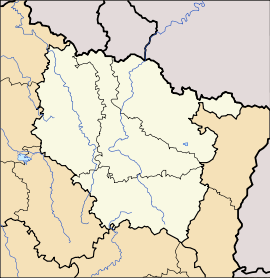Biffontaine
| Biffontaine | |
|---|---|
 | |
 Biffontaine | |
|
Location within Lorraine region  Biffontaine | |
| Coordinates: 48°12′43″N 6°48′18″E / 48.2119°N 6.805°ECoordinates: 48°12′43″N 6°48′18″E / 48.2119°N 6.805°E | |
| Country | France |
| Region | Alsace-Champagne-Ardenne-Lorraine |
| Department | Vosges |
| Arrondissement | Saint-Dié-des-Vosges |
| Canton | Brouvelieures |
| Intercommunality | Val de Neuné |
| Government | |
| • Mayor | Denis Henry |
| Area1 | 8.88 km2 (3.43 sq mi) |
| Population (2006)2 | 436 |
| • Density | 49/km2 (130/sq mi) |
| INSEE/Postal code | 88059 / 88430 |
| Elevation |
456–660 m (1,496–2,165 ft) (avg. 465 m or 1,526 ft) |
|
1 French Land Register data, which excludes lakes, ponds, glaciers > 1 km² (0.386 sq mi or 247 acres) and river estuaries. 2 Population without double counting: residents of multiple communes (e.g., students and military personnel) only counted once. | |
Biffontaine is a commune in the Vosges department in Lorraine in northeastern France.
History
In the World War II, it was liberated from German occupation by soldiers from the Japanese-American soldiers of the 442nd Regimental Combat Team in late October 1944, who defended then it from fierce counterattacks. It is perhaps best known as being near the location of the rescue of the "Lost Battalion" of soldiers from 1st Battalion, 141st Regiment, 36th Infantry Division, who had been surrounded by German but were rescued by the 442nd.The story in detail is on U.S. Samurais in Bruyeres by Pierre Moulin.
See also
References
| Wikimedia Commons has media related to Biffontaine. |
This article is issued from Wikipedia - version of the Friday, February 12, 2016. The text is available under the Creative Commons Attribution/Share Alike but additional terms may apply for the media files.